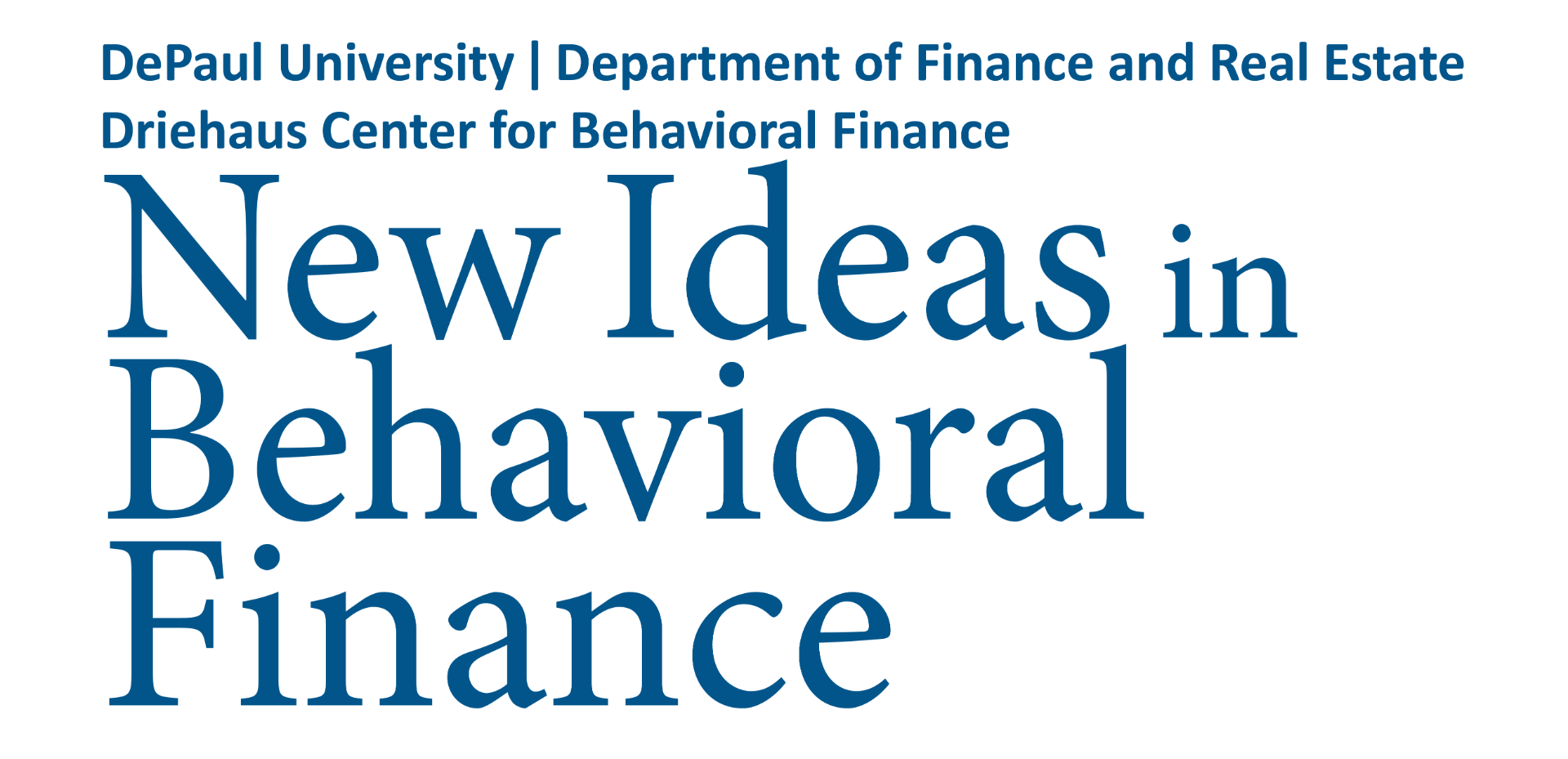Is the Current Market Level Reasonable?
By Dr. Hongjun Yan, Richard H. Driehaus Chair in Behavioral Finance, DePaul University
- It is fair to say that we are in an uncharted territory. A reasonable strategy has to be cautious. Any belief that one’s valuation model is accurate is likely to be an illusion.
- You probably don’t want to invest in a highly volatile market when you need your money back to pay your bill next month.
- If you decide to hold equity, you should diversify (hold low-cost mutual funds or ETFs), avoid individual stocks, and don’t try to time the short-term market movements.
- Historically, the long-run returns from investing in the stock market during a crisis have been higher than during an economic boom.
We are experiencing a global pandemic caused by the COVID-19 virus. Since the peak in late February, the S&P 500 index has dropped by a third over the course of a month. The market volatility has also increased drastically. The VIX index increased from 15% to over 70%. A daily swing of 5% becomes a regular occurrence for the stock market index. Is the current stock market valuation reasonable? Should an everyday investor buy stocks now? The goal of this essay is to discuss what the academic research has to say about these questions. This is not a financial advice.
I don’t have a crystal ball to predict where the stock market will be next month or quarter. Anybody who thinks he does is more likely than not to regret it afterwards. Instead, my discussion will be based on the evidence in academic research, a few very simple assumptions, and plenty of caution. Here we go.
A Rough Calculation
Is the current market level reasonable? Let’s turn this question into something arguably simpler: The S&P 500 index was at around 3200 in December 2019. That was a time when most people had no idea what a coronavirus was. Was the stock market level reasonable at that time? Let’s start our calculation with the assumption that it was. We can modify it later when needed. Now, we can make some rough calculations to assess if the current market level is reasonable.
Suppose the entire economy will grind to a complete halt, the total earnings from all S&P 500 companies will be wiped out for two years, and then everything gets back to the level in December 2019. This seems a plausible worst-case scenario. The aggregate earnings from the S&P Composite Index firms has never been negative during the last 150 years, even as the U.S. experienced two World Wars, the Great Depression, the Great Recession, and numerous financial, political, and public health crises. The largest declines in the aggregate earnings over a two-year period are 55% during the Great Depression (1930-1931) and 82% during the Great Recession (2007-2008).*
Under this extreme assumption, what would be a reasonable level for the S&P 500 index today? Since the index will be at 3200 two years later and there are no earnings in the meantime, we can simply discount this level for two years with the long-run average stock return as the discount rate (say, 9%). That gives us a level of 2688 for the S&P 500 index. As I started writing this essay on March 23, the index level was around 2300.
Now, one has to contemplate the assumption that the stock market level in December 2019 was reasonable. Certainly, the conclusion that the stock market is undervalued would not be valid if the stock market was substantially overvalued in 2019. I would not provide any opinion on the valuation level in 2019, except one observation: The discussion about the current stock market valuation has focused almost entirely on the effects of the COVID-19 pandemic.
The Economic Effects of a Pandemic
Next, let’s consider the economic impact of the COVID-19 pandemic. Since the onset of the current turmoil in the financial markets, there have been many articles examining what happened to the economy and financial markets during pandemics in history. A recent analysis (Barro, Ursúa, & Weng, 2020) on the effect of the Great Influenza Pandemic during 1981-1920 offers a reasonable anchor for our assessment.
It is estimated that the Great Influenza Pandemic killed 0.52% of the U.S. population. Worldwide, the estimated fatality is around 39 million people, around 2% of the world’s population. Examining the variations in the number of flu-related deaths across 43 countries, the study concludes that, after excluding the effect from the First World War, this pandemic caused a 1.56% drop in the GDP growth and 7% drop in the real stock market return in the U.S. Without any expertise in epidemiology, many probably will take this assessment as a plausible upper bound for the eventual mortality and economic effects from the COVID-19 pandemic.
What Should an Investor Do?
The simple analysis in Section 1 suggests that the S&P 500 index is undervalued even if the pandemic wipes out its entire earnings for two years. The evidence in Section 2 suggests that the economic effect of the Great Influenza Pandemic, which might be a plausible upper bound for the effect from the COVID-19 pandemic, is likely to be significant, but perhaps not apocalyptic. Does this mean regular investors should go all in?
Of course not! There is no guarantee that the current public health crisis will not persist. The estimates are by no means accurate. In fact, many numbers used in the above-mentioned analysis are noisy, or even speculative. Moreover, one also has to recognize the potentially substantial differences between the Great Influenza Pandemic and the current pandemic. Here is a short list of the differences:
- Modern health care and quarantine procedure can help contain the COVID-19 virus.
- More international travels make it easier to spread the COVID-19 virus.
- The mortality rate among young adults without pre-existing medical conditions appears lower in the COVID-19 pandemic than that during the Great Influenza Pandemic. This may lead to a smaller economic effect.
- Manufacturing might face larger interruptions due to the elaborate modern supply chains.
- Many economic activities can be conducted remotely, mitigating the economic effects.
- The Federal Reserve System was created only five years before the Great Influenza Pandemic hit. Many would argue that current central banks are better equipped to coordinate to contain global financial crises.
It is fair to say that we are in an uncharted territory. Any belief that one’s valuation model is accurate is likely to be an illusion. Then, does the research in finance, especially behavioral finance, offer any guidance for everyday investors? Sure.
Let me first get the two cliché advices out of the way. First, if you decide to hold equity, you should diversify (hold low-cost mutual funds or ETFs) and avoid individual stocks, unless you know more about your stocks than most investors in the market. You don’t, although many of you think you do, as illustrated by the overwhelming evidence in the behavioral finance literature in the last three decades. Second, don’t try to time the short-term market movements, unless your purpose is to seek the sensation and excitement from experiencing the gains and losses. Yes, the behavioral finance literature does show that some investors appear to be doing just that.
Does the research in behavioral finance offer anything else to regular investors? Yes. One major progress in the academic research in finance is the conclusion that the aggregate stock market return is predictable to a certain extent over long horizons (say, five years). This discovery is often attributed to the pioneering work by Robert Shiller and Eugene Fama in the early 1980s. A simple summary is that the valuation ratio (e.g., the price earnings ratio) of the stock market can predict long-run future market returns. A low-price earnings ratio is an indication that the stock market return over the next five or ten years is likely to be high. This is essentially the logic behind Warren Buffett’s famous op-ed in the New York Times during the Global Financial Crisis in 2008.
Final question: Why do long-run stocks returns tend to be higher if you invest during a crisis? The academic research has examined quite a few reasons. Let me mention two: First, studies in behavioral finance suggest that many investors may simply extrapolate from the current losses and become overly pessimistic about the stock market, leading to undervaluation during a crisis. Second, professional asset managers, who hold more than 60% of the U.S. stock market, may not want to aggressively buy stocks during a crisis due to pressures from their clients, creditors, and high market volatilities. The logic behind the second reason also suggests that everyday investors may need to limit their stock holdings if they anticipate short-term liquidity needs. You probably don’t want to invest in a highly volatile market when you need your money back to pay your bill next month.
There is plenty of uncertainty. A reasonable strategy has to be cautious. If you anticipate short-term liquidity needs, you might want to consider staying away from the current volatile market. On the other hand, historically, the long-run returns from investing in the stock market during a crisis have been higher than during an economic boom. We think we also understand some reasons behind this pattern for long-run returns. Finally, the most rewarding investment, which is often overlooked, is to invest in your human capital. Staying away from the virus may turn out to be the best investment.
*These calculations are based on the data from Robert Shiller’s website: http://www.econ.yale.edu/~shiller/.
References
Barro, R.J., Ursúa, J.F., & Weng, J. 2020. The Coronavirus and the Great Influenza Pandemic: Lessons from the “Spanish Flu” for the Coronavirus’s potential effects on mortality and economic activity (NBER Working Paper No. 26866). Retrieved from National Bureau of Economic Research website: https://www.nber.org/papers/w26866
Author Bio
Hongjun Yan is the Richard H. Driehaus Chair in Behavioral Finance at DePaul University.
His research focuses on asset pricing in the presence of frictions, including market imperfections and bounded rationality. His studies have been published in the Review of Economic Studies, Review of Financial Studies, Journal of Financial Economics, Journal of Monetary Economics, Management Science and the Review of Finance, among other journals. He also serves as associate editor of the Journal of Banking and Finance. Yan is the winner of the Best Paper Award at the 2020 GSU-RFS FinTech Conference, the NASDAQ OMX Award for the Best Paper on Asset Pricing presented at the Western Finance Association’s 2011 conference. Before joining DePaul, he taught at the Yale School of Management from 2005 to 2015, and at Rutgers University from 2015 to 2016. He has a PhD in finance from London Business School. He is thankful for Estella Yan for her big help with this essay.



